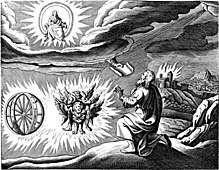
Back المركبة (قبالة) Arabic Misticisme de la carrossa celestial Catalan Merkaba German Misticismo del carro celestial Spanish عرفان مرکابا Persian Merkabah French מעשה מרכבה HE Mistisisme Merkabah ID Merkavah Italian メルカバー Japanese

Merkabah (Hebrew: מֶרְכָּבָה, romanized: merkāḇā, lit. 'chariot')[1] or Merkavah mysticism[2] (lit. Chariot mysticism) is a school of early Jewish mysticism, c. 100 BCE – 1000 CE, centered on visions such as those found in Ezekiel 1 or in the hekhalot literature ("palaces" literature), concerning stories of ascents to the heavenly palaces and the Throne of God.
The main corpus of the Merkabah literature was composed in the period 200–700 CE, although later references to the Chariot tradition can also be found in the literature of the Ashkenazi Hasidim in the Middle Ages.[3] A major text in this tradition is the Maaseh Merkabah (Hebrew: מַעֲשֵׂה מֶרְכָּבָה, romanized: maʿśē merkāḇā, lit. 'Work of the Chariot').[4]
- ^ "Klein Dictionary, מֶרְכָּבָה". Sefaria.
- ^ Falcon, Ted; Blatner, David (2019). Judaism for Dummies (2nd ed.). Hoboken, New Jersey: John Wiley & Sons, Inc. p. 74. ISBN 978-1-119-64307-4. OCLC 1120116712.
- ^ Orlov, Andrei A. (2007). "The Enoch Tradition". From Apocalypticism to Merkabah Mysticism: Studies in the Slavonic Pseudepigrapha. Supplements to the Journal for the study of Judaism. Vol. 114. Leiden: BRILL. p. 224.
However, as [Ithamar] Gruenwald notes, the main corpus of the Merkabah literature was composed in Israel in the period 200–700 CE. Some references to this tradition can be found also in the literature of German Hasidim (twelfth to thirteenth centuries CE) and medieval Kabbalistic writings (the Zohar).
- ^ Jacob Neusner (2005). Neusner on Judaism: Literature, p. 74: "When Eleazar finished the Works of the Chariot, Yohanan stood and kissed him on his head and said, Blessed is the Lord, God of Abraham. Jacob who gave to Abraham a son wise and knowing how to expound the glory of our father in heaven."
© MMXXIII Rich X Search. We shall prevail. All rights reserved. Rich X Search